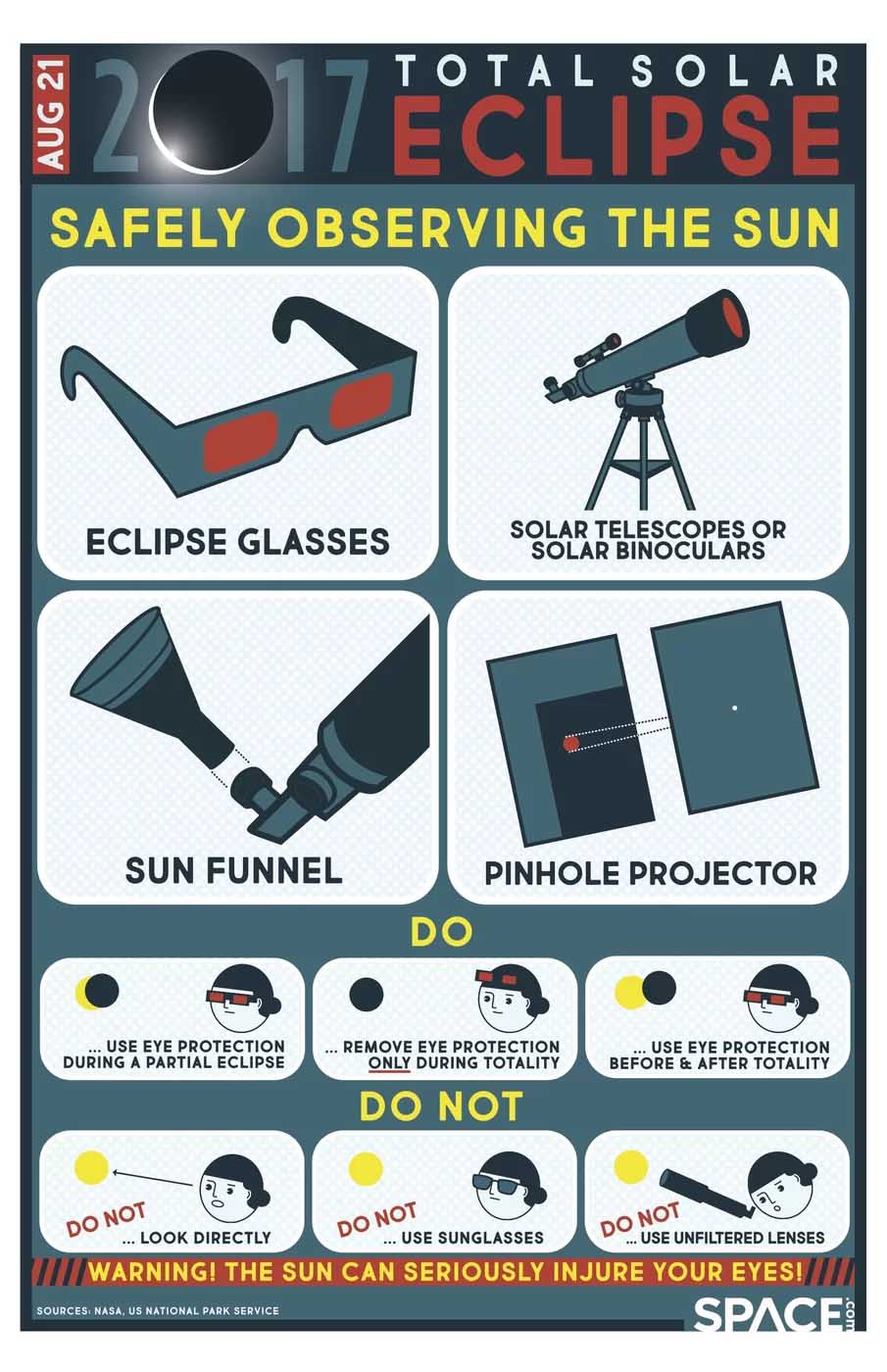Solar Eclipse Safety: How To Protect Your Eyes During Viewing!
Are you ready to witness the awe-inspiring dance of the sun and moon? It's a celestial spectacle, but looking at a solar eclipse without proper precautions can lead to permanent vision damage, including blindness.
Solar eclipses, a captivating display of astronomical alignment, have always held a unique place in human history and wonder. The sheer grandeur of the sun, momentarily obscured by the moon, draws gazes from across the globe. However, the very act of observing this cosmic ballet presents a significant risk to your most precious sense: sight. This article aims to equip you with the knowledge necessary to safely enjoy the next eclipse and prevent eye damage.
The allure of a solar eclipse lies in its rarity and the visual drama it unfolds. The sun, a radiant ball of energy, is gradually veiled, creating an otherworldly atmosphere. When the moon completely covers the sun's disk during a total solar eclipse, the sun's corona, a halo of light, becomes visible, an unforgettable image. This event, experienced by millions, is a testament to the power of the cosmos to fascinate.
Unfortunately, the unbridled beauty of the sun during an eclipse can pose a serious threat. The sun emits powerful ultraviolet (UV) and infrared (IR) radiation, even when partially covered by the moon. This radiation can damage the retina, the light-sensitive tissue at the back of the eye. The retina is responsible for sending visual signals to the brain. Damage to the retina, known as solar retinopathy or "eclipse blindness," can result in blurred vision, distorted vision, or even permanent vision loss.
The most dangerous time to view a solar eclipse is during the partial phases, both before and after totality. During these phases, a significant portion of the sun's surface remains visible, and the intensity of the light is still harmful. Even a brief glance at the sun without proper eye protection can cause damage.
Understanding the risks is the first step toward enjoying a solar eclipse safely. The dangers are not always immediately apparent. Pain receptors are absent in the retina, so damage can occur without you realizing it. By the time any symptoms like blurry vision or dark spots become noticeable, permanent harm might have already occurred. That's why eye protection is essential.
For a deeper insight into the risks, lets examine the role of Dr. Jamie Vesenka, a professor of physics who is also a leading voice on the dangers and precautions of viewing solar eclipses.
| Aspect | Details |
|---|---|
| Name | Jamie Vesenka |
| Profession | Professor of Physics |
| Expertise | Solar Physics, Eclipse Observation Safety |
| Key Statements | Emphasizes the crucial need for eye protection during solar eclipses. |
| Research Focus | Scientific accuracy and the public's understanding of eclipse safety |
| Notable Work | Numerous publications and public lectures on the dangers of unprotected eclipse viewing. |
| Website | Example Website (replace with authentic source) |
The path to safe eclipse viewing is quite clear, it is essential to equip yourself with the correct tools and adhere to guidelines to protect your eyesight. The most reliable method is to use certified "eclipse glasses" or solar viewers that meet the ISO 12312-2 international safety standard. These glasses filter out harmful UV and IR radiation, allowing you to safely view the sun during partial phases.
These special glasses should be intact, without scratches, tears, or any damage. Ensure that the glasses are properly sealed to prevent any light leakage. It is always recommended to purchase glasses from a reputable source, as counterfeit glasses may not provide adequate protection. Check the glasses before each use.
When watching the partial phases of the solar eclipse, which happen before and after totality, always use eclipse glasses or a safe handheld solar viewer. Always supervise children when using solar filters and ensure they understand the dangers and safety procedures.
If you are unable to get your hands on eclipse glasses, there are alternative safe methods. One option is to use an indirect viewing method, such as a pinhole projector. This method involves creating a small opening (pinhole) in a piece of cardboard and projecting the sun's image onto another surface. This way, you can observe the eclipse without looking directly at the sun.
Another safe alternative is to view the eclipse via live streams on television or online. Numerous organizations provide live broadcasts of solar eclipses, allowing you to witness the event without any risk to your eyes. These live streams often feature experts and provide detailed information about the eclipse.
It is crucial to remember that sunglasses, no matter how dark, are not a safe alternative for viewing a solar eclipse. Sunglasses alone do not provide adequate protection against the harmful UV and IR radiation. You must use only certified eclipse glasses or a safe handheld solar viewer.
Never look at the sun or a partial solar eclipse without the right eye protection. This is a golden rule, and it is important to follow it strictly. If you are unsure about the safety of your viewing method, it is always best to err on the side of caution and seek expert advice or opt for a safe alternative method, such as a live stream.
Only during totality is it safe to view a total solar eclipse with the naked eye, and only if the moon completely covers the sun. Totality is the brief period when the moon completely blocks the sun's disk, revealing the sun's beautiful corona. The sky darkens, and it is safe to remove your eclipse glasses briefly to witness this spectacular sight. However, as soon as the sun begins to reappear, immediately put your eclipse glasses back on.
In the United States, on Monday, April 8th, 2024, millions of Americans prepared to experience a total solar eclipse that swept across the continental US. This event, though awe-inspiring, underscores the necessity of safety precautions. The days leading up to the eclipse saw Americans making their last minute efforts to secure glasses and viewers, underscoring the public's fascination with the celestial spectacle and highlighting the importance of proper preparation.
If you are in the path of totality, the complete coverage of the sun by the moon will give you a unique opportunity to witness this total solar eclipse safely without any special eye protection for a few minutes. During totality, which is only a short period, the corona becomes visible, allowing you to appreciate the sun's outer atmosphere. It's critical to use approved eclipse glasses or solar viewers throughout all partial phases of the eclipse, and only remove them when the sun is entirely covered by the moon during totality. As soon as the sun's first rays reappear, you must put your eclipse glasses back on.
Ophthalmologists also play a critical role in educating patients about eclipse safety. They can offer scientifically accurate information on the dangers of viewing a solar eclipse and how to avoid these risks. They emphasize the risk of solar retinopathy and highlight the need for proper eye protection. Eye doctors should be seen as sources of authority for advice about safe viewing practices.
In England, a study described twenty people, aged between 15 and 82 years old, reported symptoms like black spots or blurry vision after looking at the eclipse. The incidents highlight the importance of protective measures across all age groups.
The American Astronomical Society (AAS) is an excellent source of detailed information about safe eclipse viewing practices, making it an invaluable resource for anyone preparing to witness this phenomenon. The AAS provides comprehensive guides, including how to find reputable manufacturers of eclipse glasses and other necessary safety equipment.
The decision to look at the eclipse without proper protection is a choice that can cause permanent harm. Patients are usually aware of the risk. So its important to keep the correct methods of protection in mind.
It is important to avoid looking directly at an eclipse without the correct eye protection. Looking directly at the eclipse without appropriate protection can cause eclipse blindness, a temporary loss or impairment of vision, or even retinal burns.
Alternative safe methods to view the eclipse include live streams. You can view the eclipse live on television or online. If you are using safe solar eclipse viewers, it is vital to follow all manufacturers' directions.
Safe solar viewing is simply an extension of regular sun safety. The suns harmful rays are well known, and viewing eclipses safely are equally important. This information supports a message of caution to the public.
The safest techniques for viewing a solar eclipse are indirect viewing methods. Such methods are pinhole projection techniques, or you can view live streams on tv or online. It is not safe to look at the eclipse with the naked eye, using binoculars, telescopes, or a cell phone camera. Sunglasses alone are not safe either.
The most crucial piece of advice is simple: Protect your eyes. Solar eclipses are incredible events, but your eyesight is too valuable to risk.


